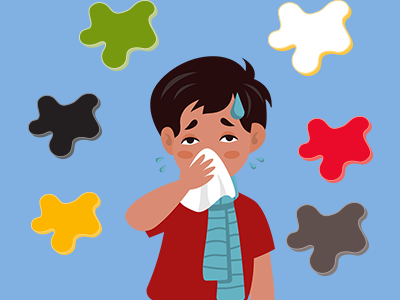Now that we’re in the thick of cold and flu season, many of us are getting more up close and personal with nasal mucus, or snot, than we’d like. But did you know that snot color can actually tell you a lot about your health?
Mucus plays an important role in your body. The sticky substance is the first line of defense in terms of preventing infections and fending off things like bacteria, viruses and dust that might enter your body through your nose. When there are more germs present, your body makes more mucus to trap them and get them out of your body. Because of this important role, snot can take on different colors depending on how it adapts to what’s going on in your body. That’s why it’s actually a good thing to take a look at what’s in your tissue.
Clear snot
Clear snot is a good thing. It’s considered “normal” or healthy. However, if you’re also experiencing a large amount of nasal discharge, you might have allergies or hay fever.
White snot
If you’re feeling congested or stuffy, you may notice your snot is cloudy and clumpier than usual. White snot is caused when mucus loses water and becomes thick and cloudy. Often, white snot goes hand-in-hand with the common cold. Other symptoms include a sore throat, congestion, coughing or a low-grade fever.
Yellow snot
Yellow snot is a sign that your body is fighting off an infection. Your white blood cells are fending off a virus or bacteria and the dead cells give snot a yellow or brownish tint. While yellow snot isn’t something to worry about, you should keep track of when it started to determine how fast your body is healing. If, after 10 days, your snot is still yellow, you should contact your doctor.
Green snot
When your snot is green, it means your body is working really hard to get rid of an infection. More and more white blood cells are being called into action and the waste products from their fight against germs are turning your snot green.
Green snot can also indicate a sinus infection. Other symptoms include congestion and sinus pressure or headaches.
If you’ve been feeling sick for more than 10 days, have green snot along with a headache or fever, it’s probably time to call your doctor.
Reddish/pink snot
Red or pink snot usually comes from blood and indicates your nasal passage is dry or irritated or that you’ve had some sort of nasal trauma. This can happen if you’ve been hit on the nose or if your nose is dried out from cold, dry weather or over-blowing. Try using a nasal spray, a thin layer of petroleum jelly or a humidifier to get rid of dryness. If the red snot is accompanied by excessive nosebleeds or difficulty breathing, you should call your doctor.
Brown/orange snot
Brown or orange snot often follows red/pink snot and is caused by old, dried blood leaving the body. It can also occur if you’ve inhaled a lot of pollution or dirt that discolors your mucus.
Black snot
Black snot generally means you’ve got a fungal infection. While it isn’t common, it is serious, and you should contact your doctor. Black snot also occurs if you’ve inhaled a lot of smoke or dirt/dust.
It’s always a good idea to know what’s going on inside your body. If you notice a change in your mucus that concerns you, or if a color change occurs alongside other symptoms such as difficulty breathing, dehydration, pain or symptoms that last more than 10 days, you should contact your doctor. It’s also important to remember that while the color of your mucus can tell you a lot about what’s going on inside your body, the duration of the nasal discharge and how your child is feeling should ultimately determine whether you call your doctor.

Download our snot color infographic here.
 https://riseandshine.childrensnational.org/wp-content/uploads/2023/08/boy-on-couch-using-tablet-feature.png
300
400
Rise and Shine
https://riseandshine.childrensnational.org/wp-content/uploads/2017/11/childrens_riseandshine_logo.jpg
Rise and Shine2023-08-24 11:39:072023-08-24 11:50:41Screen use and headaches in children: 6 strategies to help
https://riseandshine.childrensnational.org/wp-content/uploads/2023/08/boy-on-couch-using-tablet-feature.png
300
400
Rise and Shine
https://riseandshine.childrensnational.org/wp-content/uploads/2017/11/childrens_riseandshine_logo.jpg
Rise and Shine2023-08-24 11:39:072023-08-24 11:50:41Screen use and headaches in children: 6 strategies to help






















Thanks for the snot information – so timely and useful at this time of year.
Great read!